|
A once-popular bumper sticker claimed that God makes house calls. If 976-EVIL, the 1988 directorial debut of actor Robert Englund, is anything to go by, the Devil makes phone calls instead.
It all kicks off with the sort of prologue that became de rigueur in 80s horror and beyond, where something explosively bad happens to someone we’ve never met. Such prologues are designed to give us a taste of the horrors to come and reassure the short-attention-span audience that there’ll be fireworks later. With that out of the way we meet our principal characters, the most initially intriguing of whom is nerdy, put-upon teenager Hoax (Stephen Geoffreys). He lives with his mother Lucy (Sandy Dennis), an intolerant, southern bible-thumper with a different wig for every occasion who bullies Hoax almost as relentlessly as the kids do at school. Living in a shack above the garage across the yard is Hoax’s cool, Harley-riding cousin Spike (Patrick O’Bryan), to whom Hoax sends messages via a homemade pneumatic tube transport system. Hoax clearly idolises Spike, and while Spike seems to do little more than tolerate Hoax, he does seem to genuinely wish him no ill. Spike’s also a bit of gambler, and as the film proper begins he lands himself in hock to a style victim named Marcus (J.J. Cohen) after losing heavily to him at one of his poker games. Marcus is the nominal ringleader of a quartet of school bullies and could only have looked intimidating to anyone in the 1980s, when teenage boys believed they could look tough by dying their hair two different colours and wearing a brimmed hat at a rakish angle. Marcus and his mates really have it in for Hoax, and while Spike is happy to plays cards with this motley crew, when he catches two of them shoving Hoax’s head down a toilet in the most graffiti-splattered school washroom I’ve ever seen, he quickly steps in and smacks them six ways from Sunday.
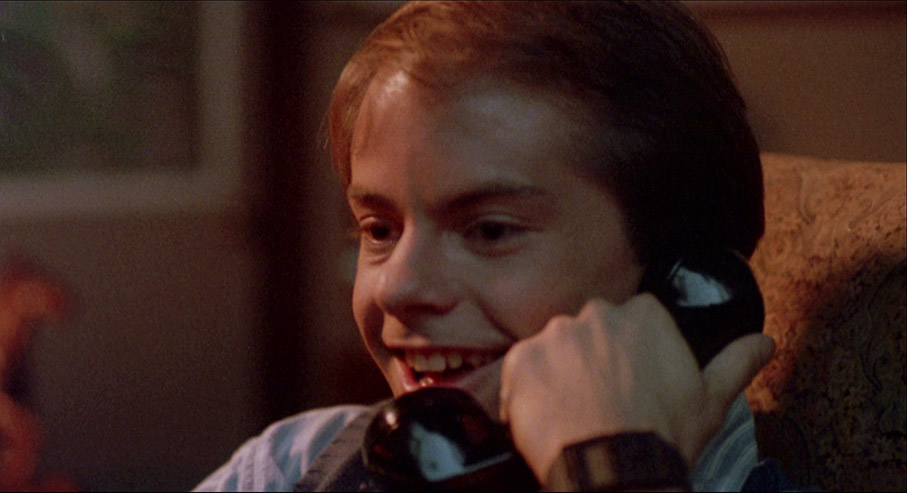
So what’s with that title? Well, if you live outside of the US and were born in the last 20 or so years then there’s a chance you’ve never even heard of 976 phone numbers. These were premium rate lines that you could call to hear anything from weather forecasts to women talking dirty. Their seven-digit numbers all began with 976, with the last for digits making use of the letters on the telephone keypad to in some way indicate the service being offered. The one being pushed here is a novelty horoscope, and if you’re young enough to be bemused by that statement, well, lucky you. I’m not going to get into what horoscopes are or claim to be (look it up if you somehow don’t know), but for reasons that have always escaped me they were once preposterously popular. Breakfast TV shows even had resident astrologers who’d be wheeled out each day to talk a lot of generalised bollocks that could apply to just about anyone and claim it was somehow all written in the stars. Do me a favour. An astonishing number of people took this claptrap seriously, but many others who claimed not to swallow a word of it would check out their horoscopes anyway, “just for a laugh.” Oh yeah, I’m splitting my sides. If it seems I’ve gone off track then I only mention this to help clarify why a couldn’t-give-a-crap guy like Spike would call a number he finds on a flier offering to tell him his ‘horror-scope’ instead of tossing it in the nearest bin as I would have. When he does so, the reading he gets seems oddly relevant to his current financial woes and the encouragement it offers sees him sneak into the house and steal money from Aunt Lucy’s kitchen hideaway. When Aunt Lucy confronts him and encourages him to repent, it suddenly starts raining fish, which delights the hell out of Hoax and convinces Lucy that she’s received a sign from God. The incident even attracts the attention of genial Modern Miracle magazine reporter Marty Palmer (Jim Metzler), who turns up at Lucy’s door and ends up looking into the source of this mysterious telephone line.
Later, when poking around in Spike’s room for reasons I won’t go into, Hoax finds the horror-scope flier and also gives it a call. The advice dished out this time lands him an off-the-cuff date with Spike’s girlfriend Angela (María Rubell), whom Spike has temporarily abandoned for another card game. When the date turns sour and Hoax calls the line a second time, however, the action he is pushed into taking has more serious consequences for him and those around him.
On the surface, 976-EVIL is an offbeat horror flick built around the gimmick of a satanic phone line that employs the lure of phone-in horoscopes to snare the right sort of callers and transform them into demons. Lurking beneath is the tale of a bullied and lonely misfit who is transformed into a vengeful monster, ostensibly by a demonic phone line but in truth by the people who shit on him on a daily basis. Structurally, it both meets and plays games with expectations, to a degree that it can sometimes feel a little ramshackle but not in a detrimental way. This is particularly true of the characters, few of whom perform the narrative function they seem to have been assigned when we first encounter them: the sympathetic lead evolves into the film’s monster; the rebellious substitute hero takes a back seat in a crucial part of the story and is temporarily replaced by a third party; a potential heroine is killed off in the first half and the replacement doesn’t turn up until the halfway mark and even then only starts to fulfil that role considerably later. One thing you can’t call 967-EVIL is predictable.
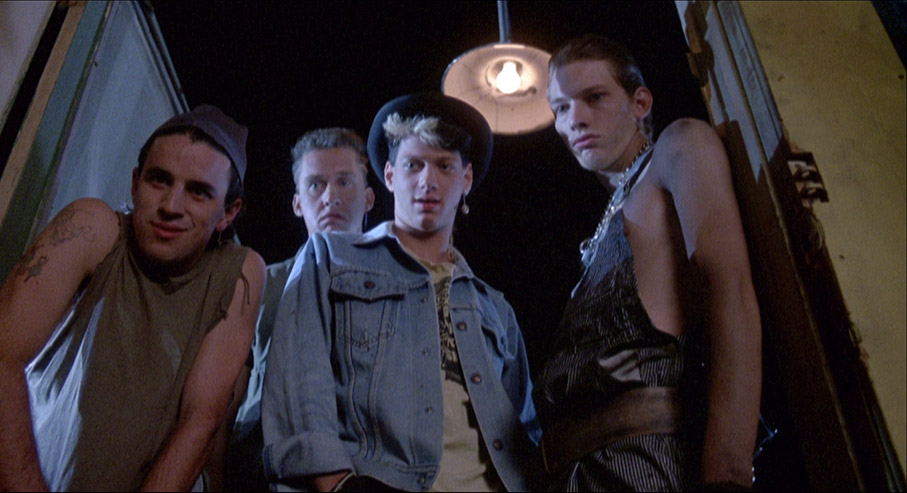
As you might hope in a film directed by an experienced actor, the roles are nicely cast and performances are solid across the board. As Hoax, Stephen Geoffreys may not be quite as gloriously out-there as he was in Fright Night, but there’s still a whiff of Evil Ed in his wide-eyed delight at the rain of fish, and once he develops demonic powers he has an absolute ball. He also gets most of the second half’s best lines and scene-stealing moments. His grisly suggestion regarding how he might join one of Marcus’s poker games is a gem I dare not spoil, but a personal favourite comes when one of his former tormentors is fearfully awaiting his arrival, only for Hoax to suddenly appear beside him, rest his arm on his shoulder and casually ask, “Who are we waiting for?” Sandy Dennis was clearly encouraged to go the whole nine yards as Lucy, but still peppers her portrayal with lovely little bits of business – the way she concludes her tale of how it rained God’s fish by looking skyward and reverentially exclaiming, “His fish!” always gets me giggling. Pat O'Bryan effortlessly exudes toughness and cool as Spike, Jim Metzler makes for a most likeable Marty, and there’s a delicious cameo from Robert Picardo as the hypochondriac manager of the company in which the supposedly deactivated horror-scope line is located. I’ll also give a shout out to J.J. Cohen, who despite being saddled with the film’s most 80s character, brings an unexpected level of nuance to the role of Marcus, from his smart delivery of sometimes gifted lines to the look of weary disappointment on his face as he calmly watches as Spike beats up his friends for bullying Hoax.
Where the film really shines is in its attention to oddball detail. Even the smaller roles are made memorable by a line of dialogue, a character trait or the performance, from the bully (Gunther Jensen) who indignantly corrects Spike for calling him Skinhead (“The name’s Airhead!”) to the waitress (Roxanne Rogers) who clearly detests her job and takes orders with all the enthusiasm of someone ordered to clean out diarrhoea ward toilets on curry night. Visually and aurally the film is definitely a product of its day, with a fondness for brightly coloured lighting and character backlighting, synth-driven music and creative prosthetic makeup effects, but all are nicely done and have a cosy nostalgic appeal.
Despite only having previously seen the film once back in the early 90s, I was surprised how closely it mirrored how I remember it playing. It isn’t particularly scary (unless you hate spiders, which I bloody well do) but it is a great deal of goofy and sometimes grisly fun, at least if you’re willing to put aside any expectations created by the knowledge that it was directed by the man who played Freddie Krueger in the Nightmare on Elm Street movies. The concept is neat, the script (by Rhet Topham and Brian Helgeland) is wittier than I recall, the direction is confident, the performances are way better than the low-budget horror norm, and the constant stream of creatively offbeat detail is a treat. Indeed, it’s those oddball elements that made the strongest impression on my first viewing, the most vividly remembered of which sees Hoax use his pneumatic tube system to send Spike a note inside the mouth of one of the sky-fallen fish.
A strong 1.85:1 transfer with rich reproduction of the film’s lively colour palette, clearly defined detail and a contrast balance that gives the image punch without eating up the shadow detail and it copes nicely with the intermittent use of character backlighting. A fine film grain is visible and the image is clean of dirt and damage.
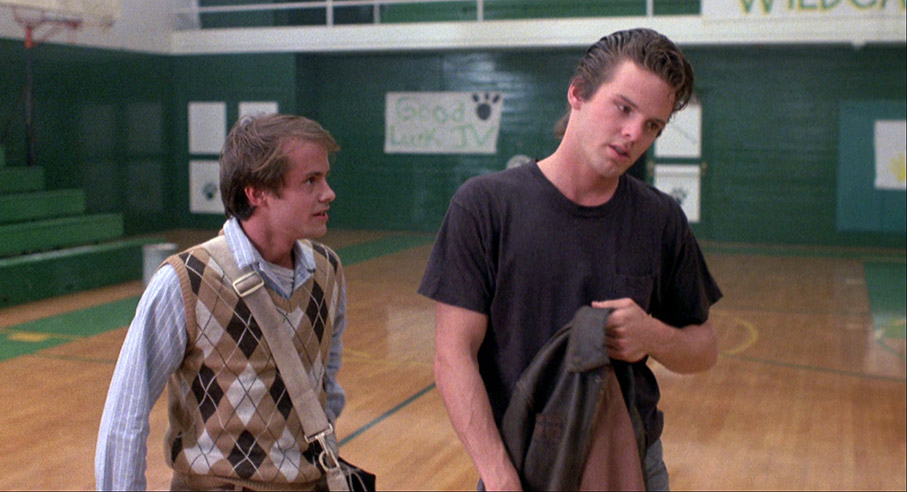
The original stereo soundtrack is available as a Linear PCM 2.0 track, but this has been joined by a DTS-HD Master Audio 5.1 surround remix, and while the stereo track is fine, surround is the way to go. The sound here has more breadth and feels richer than the stereo, and when the action hots up, the music and effects are spread inclusively around the room.
Optional English subtitles for the deaf and hearing impaired have been included.
Audio Commentary with Robert Englund and Nancy Booth Englund
An entertaining commentary from director Englund with occasional contributions from his wife Nancy Booth Englund, whom he met and fell for in the process of making this film, on which she was the set decorator. The actor in Englund keeps surfacing in his almost Freddie Krueger-like delivery of comments on the action, but he does reveal quite a bit about the film’s making, recalling the cooperative cats and the stubbornly immobile spiders and revealing why he cast particular actors, how Sandy Dennis’s performance was an inspiration for the film’s slightly over-the-top style, and lots more. He mentions scenes that were cut from the theatrical print – one of these is in the VHS version detailed below, while information on the others does clarify a couple of plot points. He explains what 976 numbers were for a generation that has grown up with the internet and mobile phones, praises the makeup effects and Stephen Geoffreys’ performance, and suggests that when Lucy first confronts Spike she’s actually turned on by him – once he pointed this out I could see what he was getting at from little moments in Sandy Dennis’s performance that I’d not previously picked up on. The comment that made me smile the most, however, comes from Nancy when she notes, “’87 was not a kind year for fashion.”
976-EVIL Extended VHS Release (104:39)
When the film was released on VHS, some sequences that had been cut from the theatrical print were re-inserted, extending the running time by 13 minutes to (almost) 105 minutes. Rather than just include the extra scenes, Eureka have gone the whole hog here and have presented the entire VHS version as a special feature. The film is framed in the 4:3 aspect ratio, as it was on the VHS release, and is an open matte print, which adds picture information at the top and bottom of frame rather than cropping the sides. And for an SD VHS version (albeit one presented at 720p), it doesn’t look half bad. I don’t know the film well enough to be able to identify if the timing or position of individual shots have been changed, but had no trouble spotting a number of additional dialogue exchanges (most if not all of the extra material is dialogue-based). It’s all of interest. Most of the new material expands on existing scenes and in a couple of cases help clarify plot points that are otherwise a little opaque. I’m not in a position to make an exhaustive list, but here are a few additions that I spotted with the occasional comment on how they impact on the story or characters.
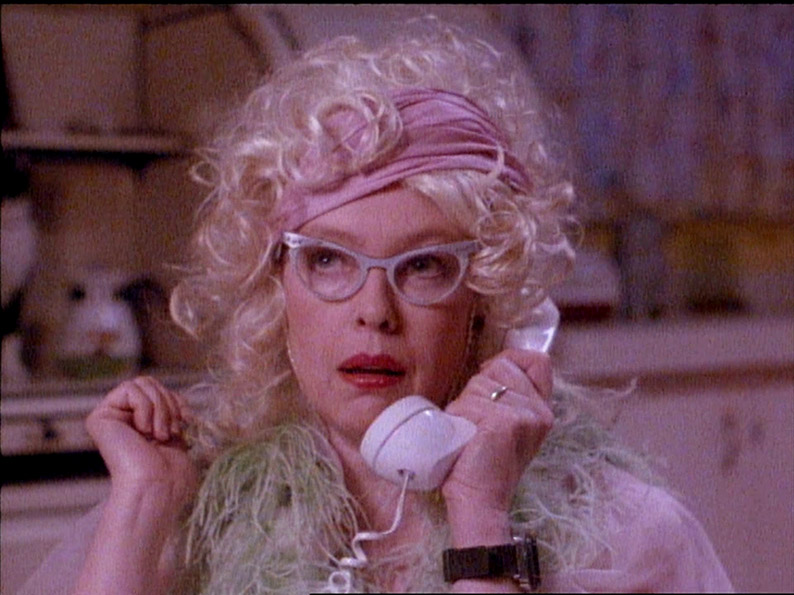
| |
In this version, Marty doesn’t turn up at Lucy’s door out of the blue as he does in the theatrical print but in response to a call that Lucy makes to Modern Miracle magazine. This helps explain why her attitude to him changes so suddenly when he announces who he is. |
|
| |
School principal Angela Martinez (María Rubell) makes her first appearance earlier in this version when a gushing Hoax is shown doing jobs for her for extra credit and she has to kindly but repeatedly encourage him to leave when he has finished. Hoax clearly has a serious crush on her. |
|
| |
Lucy’s chat with Marty about the rain of fish goes on for much longer here and ends with a slapstick gag that sees Marty knocked off his feet when Lucy opens the fridge door and the floor is flooded with slippery sea creatures. |
|
| |
Later, an uncomfortable-looking Marty is seen dressed in what looks like one of Lucy’s nightdresses while a contented-looking Lucy dries his wet clothes. When Spike arrives home and enters his shack, Marty asks about him, and when he learns that Hoax was a witness to the shower he says he’d like to talk to him. |
|
| |
Marty chats to Hoax in his bedroom, where a genial Hoax plays with a spider while they talk and explains that he and Spike built the message tube some years ago. He then erroneously claims he has outgrown it but Spike still likes to use it. Marty then discovers a doll with a black hood over its head and a noose around its neck, which Hoax reveals he has placed there to mess with his mother when she pokes around in his room, which she often does. |
|
| |
In the café scene in which Marty attempts to talk to Spike about the rain of fish, Spike angrily reveals that the house is actually his and that Lucy has guardianship over it until he is 21. This clarifies an earlier exchange in the theatrical cut in which Lucy catches Spike stealing what we assume is her money – he claims he is only taking what is rightfully his, to which Lucy responds that he has no claim to it until he is 21 and she can do what she likes with it until then. |
|
| |
When Hoax is looking around in Spike’s room, the scene is extended here with Spike unexpectedly returning and catching Hoax, who claims he thought he heard someone in the room. Spike demands Hoax turn out his (empty) pockets, then remarks that his cousin never has any money and gives him some, which delights the grateful Hoax. |
|
| |
When Marty turns up at the school, identifies himself as a private investigator and asks Angela if he can speak to Spike, the scene now continues inside of Angela’s office. She immediately challenges the validity of an ID that she saw through as a fake and Marty sheepishly admits that he is a reporter. This, together with the earlier sequence in which Lucy calls Modern Miracle magazine, confirms that he does indeed work for the publication and is just pretending to be a private eye. In the theatrical cut, it’s less certain that this is the case and there’s even a suggestion that the reverse is true, that he’s a private eye masquerading at a Modern Miracle writer (more on this below). He also asks Angela out to dinner in this scene. |
|
| |
When Angela and Marty are having dinner – something that comes out of the blue in the theatrical cut, though you can fill in the gaps yourself – Marty talks more about his work on the magazine, much of which prompts mocking laughter from Angela. The removal of this footage only strengthens the inference Marty as a private investigator in the theatrical cut. |
|
Kevin Yagher Interview (18:31)
A new interview with the film’s make-up effects supervisor Kevin Yagher, who had just started work on Child’s Play at the time of filming and only accepted this job because he was asked to do it by Robert Englund, with whom he had developed a close working relationship and friendship on the first three Nightmare on Elm Street movies. Unsurprisingly but pleasingly, he provides details of a number of the make-up effects and even has one of the mechanical finger prosthetics used in the film to demonstrate how it works.
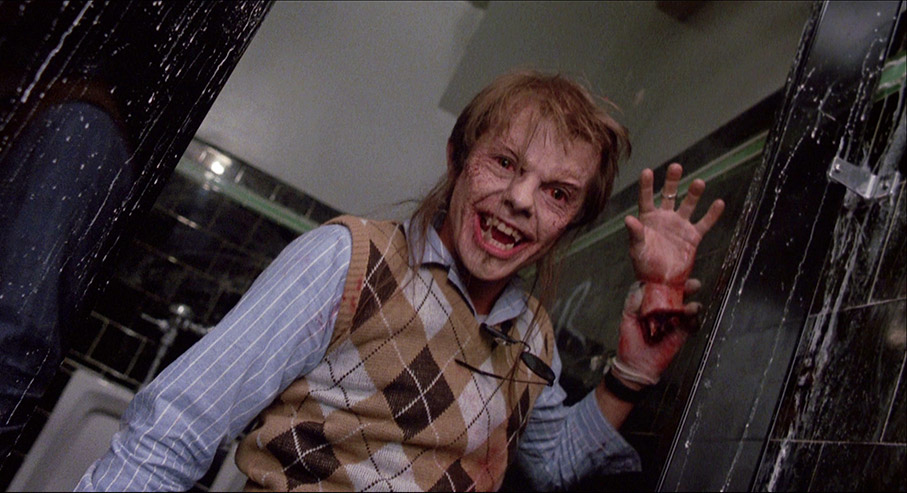
Howard Berger Interview (10:40)
Make-up effects assistant Howard Berger recounts how he and Bob Kutzman were brought onto the film by Kevin Yagher, who was dividing his time between 976-EVIL and Child’s Play. He’s every bit as enthusiastic for his craft as Yagher, from whom he happily admits he learned a great deal, and has nothing but praise for Englund as a director. He reveals that the thing he and Kutzman were most excited about was the chance to work with Robert Picardo for a day, and seems oddly surprised that people still watch films made a few decades ago. Come on man, that’s almost all some of us watch.
Lisa Hansen Interview (17:55)
Producer Lisa Hansen, who bristles with cheerful self-confidence and a genuine love for movies, recalls being “scared shitless” by horror films in her younger days and recounts her journey into the film industry and becoming a producer on 976-EVIL. She talks about securing Englund as a director, casting the main roles, hiring make-up effects man Kevin Yagher and cinematographer Paul Elliot, and sells her skills as a producer with a tale of how they were able to keep filming beyond the agreed cut-off time on their night shoot permit.
Image Gallery
32 screens devoted to the film’s makeup effects, primarily those created for Hoax’s transformation from human into demon.
Booklet
Apart from the film credits and the usual viewing advice, this booklet only features a single essay by film scholar Craig Ian Mann, but it’s a damned fine one, examining the film’s initial reception and perceptively exploring its underlying themes. Watch the film and then read this and you will likely want to see it again with Mann’s observations in mind.
It was strangely comforting to return to 976-EVIL after so long a break and enjoy it as much as I remember once doing. It’s a fun low-budget horror work with a decent script, good performances, well-done effects and some style, and it’s not hard to see why it has developed a bit of a cult following in the years following its release. Eureka have done a knockout job on this release, with a very fine transfer and a decent collection of extras, including the entire extended VHS version of the film. Oh yes, I’m going to have to recommend this one.
|